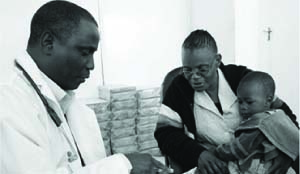MOPANI has rightly earned the recognition and support of the Zambian Government for working tirelessly to eradicate malaria, one of the killer diseases.
The mere mention of Mopani Copper Mines Plc inevitably raises the antenna on mining, for that is the core business of this globally-recognised firm.
Mopani is an integrated copper and cobalt producer owned by Carlisa Investments Corporation, a joint venture company registered in Zambia comprising Glencore International AG, First Quantum MineralsLtd, and Zambia Consolidated Copper Mines (ZCCM)-Investment Holdings.
The unit, which has over 20,000 employees in Zambia, has invested more than US$2 billion over the past 14 years of its operations in the country.
The mining firm has also invested $323 millionin a deep mine copper project dubbed the Synclinorium Shaft, which is expected to be commissioned in the second quarter of 2015.
The Synclinorium Shaft is designed to extend the lifespan of the Nkana copper mine in Kitwe to 25 years with access to 115 million tonnes of mineral ore.
Mopani is also upgrading its cobalt plant at a cost of$27 million to enable it double the current production capacity to 7,000 tonnes from the current 2,800 tonnes by 2015.
The company has further invested more than K2.3 billion in upgrading the Mufulira smelter over three phases to reduce sulphur dioxide emissions by 97 per cent.
It, therefore, sounds odd for Mopani to win accolades in a different field away from mining, but that denotes the desire by the mine managers to spread the company’s services beyond its core business.
Malaria
It also goes to show how the company appreciates the importance of health for its employees, their families and the communities in which Mopani operates.
Malaria is one of the lethal diseases in Zambia, accounting for more than 3.5 million cases and 50,000 deaths every year, according to the Ministry of Health.
It is a major feat that since 2000, Mopani has been spending an average of US$500,000 annually on implementing various malaria control programmes, whose preventive measures include adult mosquito control through the Indoor Residual Spray Campaign, and larvae control through the use of environmentally-friendly pesticides and chemicals in drainages and ponds with stagnant water.
The company also distributes free Insecticide Treated Nets to expectant mothers and children under the age of five.
In recognition of such unwavering efforts, the Mopani Copper Mines’ malaria prevention programme has received a major boost following the donation of 5,000 litres of Indoor Residual Spray chemicals worth $150,000 (over K900,000) from the Ministry of Health.
The contribution of 5,000 litres of the newly-recommended ACTELLIC 300 CS chemical was made through the Kitwe District Health Management Board (KDHMB).
Kitwe District Medical Officer Chikafuna Banda did not mince his words when he said the donation is a demonstration of the Government’s confidence in Mopani’s consistent anti-malaria campaign, which has over the years managed to reduce the incident rate from around 216 per 1,000 people in 2001 to less than 15 per 1,000 people in its catchment area as of July 2014.
“It is so important that coming from the Government, we show appreciation of the efforts from Mopani in the fight against malaria,” Banda said.
“It is our hope that this cordial relationship between the Ministry of Health and Mopani continues as we both continue to work towards improving the lives of the Zambian people.”
Recent research shows that mosquitoes have evolved to survive a number of the existing control products such as the Lambda chemical, which was previously used in malaria vector control in Zambia.
As a result, this is now posing a threat to the effective prevention of the disease.
Mr Banda said following the World Health Organisation (WHO) recommendation for the use of ACTELLIC 300CS in malaria vector control, Zambia adopted it as the new Indoor Residual Spray chemical to be used for the next two years so as to counteract the mosquitoes’ resistance to the Lambda chemical.
The mining company management is elated by the positive results from the malaria control interventions.
“Our malaria control interventions have resulted in less deaths and contributed to a significant drop in hospital admissions, which is a big plus as it means more productive hours for our staff and less expenditure on malaria treatment,” says Mopani Chief Executive Officer, Danny Callow.
Callow thanked KDHMB for the contribution which he said would go a long way in enhancing the company’s anti-malaria outreach programme in Kitwe and Mufulira.
With the contribution from KDHMB, Mopani’s current target of 36,000 to 40,000 households per year under the Indoor Residual Spray programme in both Mufulira and Kitwe will greatly increase.
“We are happy to partner with the Government in the fight against malaria because not only does malaria have a negative impact on our productivity as a company through increased absenteeism and medical costs, but the disease also greatly affects the general well-being of the community and the country at large.
“We shall endeavour to continue with our anti-malaria programmes aimed at prevention, treatment and care for the communities around us,” Callow said.
He further said since the launch of the anti-malaria programmes in 2000, Mopani has spent over US$6 million (more than K37 million) in Kitwe and Mufulira.
By dedicating part of its resources to the fight against malaria, Mopani has ably demonstrated its desire to ‘heal’ the local communities by providing jobs through its mining ventures as well as providing healthcare services.— SOLWEZI TODAY







